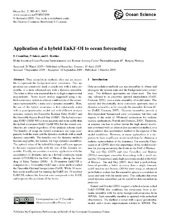| dc.description.abstract | Data assimilation methods often use an ensemble to represent the background error covariance. Two approaches are commonly used; a simple one with a static ensemble, or a more advanced one with a dynamic ensemble. The latter is often non-practical due to its high computational requirements. Some recent studies suggested using a hy- brid covariance, which is a linear combination of the covariances represented by a static and a dynamic ensemble. Here, the use of the hybrid covariance is first extensively tested with a quasi-geostrophic model and with different analysis schemes, namely the Ensemble Kalman Filter (EnKF) and the Ensemble Square Root Filter (ESRF). The hybrid covariance ESRF (ESRF-OI) is more accurate and more stable than the hybrid covariance EnKF (EnKF-OI), but the overall conclusions are similar regardless of the analysis scheme used. The benefits of using the hybrid covariance are large compared to both the static and the dynamic methods with a small dynamic ensemble. The benefits over the dynamic methods become negligible, but remain, for large dynamic ensembles. The optimal value of the hybrid blending coefficient appears to decrease exponentially with the size of the dynamic ensemble. Finally, we consider a realistic application with the assimilation of altimetry data in a hybrid coordinate ocean model (HYCOM) for the Gulf of Mexico, during the shedding of Eddy Yankee (2006). A 10-member EnKF-OI is compared to a 10-member EnKF and a static method called the Ensemble Optimal Interpolation (EnOI). While 10 mem- bers seem insufficient for running the EnKF, the 10-member EnKF-OI reduces the forecast error compared to the EnOI, and improves the positions of the fronts. | en_US |
